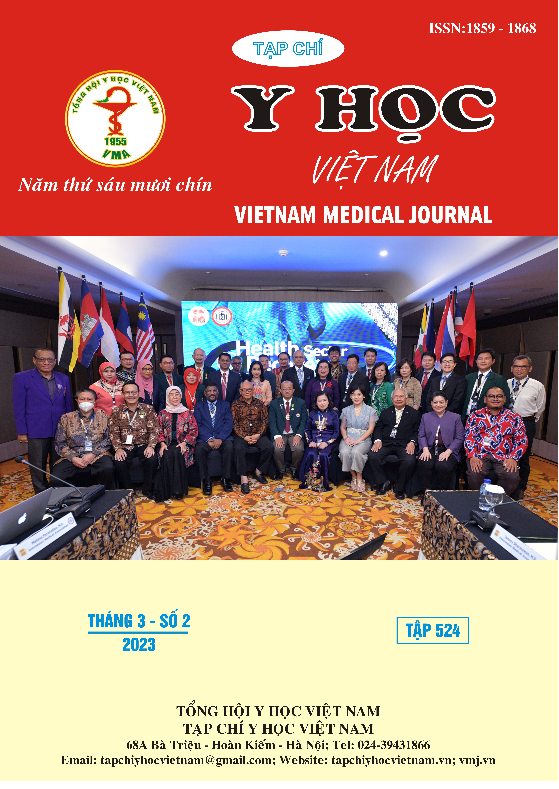THE RESULT OF URGENT LAPAROSCOPIC CHOLECYSTECTOMY FOR ACUTE CHOLECYSTITIS
Main Article Content
Abstract
Study aims: + Evaluation of clinical feature of acute cholecystitis. +Result of urgent laparoscopic cholecystectomy for acute cholecystitis. - Patient and method: + Restrospective study. + Time: 2008-2011. - Result: There were 25 patients,mean age was 51,4±14,3; Sex ratio female/male was 2:1. Clinical finding were abdominal pain in all patient, (right upper quadrant pain), fever (more than 38º) in 100%, gallblader distention in 72,0%, Murphy'sign positive in 64,0%, Elevation of leucocyte in 72% (more than 10.000/mm3). Adominal ultrasound: gallstones in 88,0%, alythiasis in 12,0%, obstruction of cystic duct by stones in 48%,thickness of gallblader wall in 17 patients (68,0%,more than 3mm), presence of pericholecystic fluid in 64,0%. Surgical management consist of urgent laparoscopic cholecystectomy in all patients; conversion to laparotomy in 6 patients (24%) due to bleeding (33,3%), injury to common bille duct or common hepatic duct (16,7%), or adhesive, thickness, necrosis of gallblader wall (50,0%). The average operating time was 68,4±22,6 minute (range 28-125 minute). The average hospital stay was 5,02±2,36 days (from 2-35 days). There was no death per and postoperation.Complication were 6 patient (24%) consisting of suppuration of trocar site (4 patients), bleeding of trocar site (2 patients). - Conclusion: We conclude that. + The proportion of acute cholecystitis was about 10,0% (of 248 patients who laparoscopic cholecystectomy were perfomed during the same period). Of them, 88,0% were gallsonecholecystitis, 12,0% were acaculous cholecystitis. + Laparoscopic cholecystectomy was performed in 76,0%, conversion to laparotomy in 24,0%. + The main reasons for conversion were bleeding (2 patients), injury to common bile duct or common hepatic duct (1 patient), thickness, necrosis of gallblader wall or adhesive to surrounding tissues. + The average hospital stay was 5,02±2,36 days (range from 2-35 days). + There was no death per and postoperation.
Article Details
References
2. Lê Quan Tuấn Anh, Nguyễn Hoàng Bắc: Các Dạng động mạch túi mật khảo sát qua cắt túi mật nội soiHội nghị phẫu thuật nội soi và nôi soi toàn quốc (2006);63-64.
3. Nguyễn Ngọc Bích và CS: Những nhận xét về phẫu thuật cắt túi mật nội soi tại BV Bạch mai.Hội nghị phẫu thuật nội soi và nôi soi toàn quốc (2006); 53-54.
4. Nguyễn Văn Hải (2018):Viêm túi mật cấp.Câp cứu ngoiaj tiêu hóa.NXB Thanh niên:91-101
5. Từ Đức Hiền và CS: Phẫu thuật nội soi cắt túi mật trên bệnh nhân có đường mổ cũ.Hội nghị phẫu thuật nội soi và nôi soi toàn quốc (2006);34-35
6.. Thái Nguyên Hưng, Hà Văn Quyết, Nguyễn Văn Huy (2009): Những thay đổi giải phẫu đường mật trong gan ứng dụng trong nội soi đường mật. Y học thực hành 7,tr93-94.
7. Thái Nguyên Hưng: Nghiên cứu ứng dụng nội soi đường mật bằng ống soi mềm kết hợp với tán sỏi điện thủy lực trong mổ mở để chẩn đoán và điều trị sỏi đường mật. Luận văn tiến sỹ Y học. (2009)
8. Đào Tuấn, Phan Ngọc Chúc: Kết quả cắt túi mật nội soi tại BV Saint Paul Hà nội.Hội nghị phẫu thuật nội soi và nôi soi toàn quốc (2006);67-68.
9. Nguyễn Tuấn,Phan Thanh Nguyên: Kết quả cắt túi mật nội soi trong viêm túi mật cấp do sỏi.Hội nghị phẫu thuật nội soi và nôi soi toàn quốc (2006);54-55.
10. Bray Madoue Kaimba, Youssouf Mahamat et Seid Dounia Akouya: Cholecystectomy pour cholecystite aigue lithiasique: à propos de 22 cas à l'hopital de la renaissance de NDjamena.The Pan African Medical Journal 2015;21:311.


